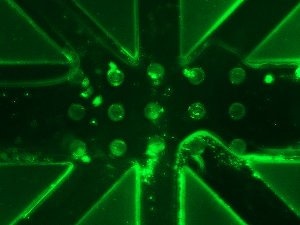Mar 29 2018
A microsensor that enables direct monitoring and adjustment of the composition of kidney dialysis fluid has been developed by scientists at TU Eindhoven. This is a significant step forward in patient-specific dialysis, which will eliminate a considerable proportion of the severe side effects of using standard dialysis fluid. Manoj Kumar Sharma will be awarded a Ph.D. for his studies on this sensor, on March 29, 2018.
 Microscope picture of the microfluidic device developed by Manoj Sharma. The horizontal stripe is the microchannel, which measures 0.2 mm across. The six other stripes are optic fibers that capture the fluorescent light and lead it to a spectrometer. The fifteen dots in the middle are micropillars. (Image credit: TU Eindhoven)
Microscope picture of the microfluidic device developed by Manoj Sharma. The horizontal stripe is the microchannel, which measures 0.2 mm across. The six other stripes are optic fibers that capture the fluorescent light and lead it to a spectrometer. The fifteen dots in the middle are micropillars. (Image credit: TU Eindhoven)
Globally, kidney failure renders nearly two million people reliant on kidney dialysis to purify their blood. A tube is linked to a blood vessel and the blood is made to pass through a membrane, with dialysate, or the dialysis fluid, on the other side. Since the concentration of salts in the blood is greater than in the dialysate, the salts pass along the membrane and enter the dialysate. The rate at which this occurs is reliant on the discrepancy in concentration between dialysate and blood.
Due to the fact that the concentration of salts largely differs from patient to patient and that the dialysate’s concentration remains standard, the speed is usually not ideal. This results in severe side effects, such as renal bone disease and heart rhythm disturbance. Hence, it is advisable to constantly adjust the concentrations of salts in the dialysate to be ideal for the patient. However, this mandates the live monitoring of the concentrations of salts in the dialysate. Yet, to date, there has been no reliable method to ensure this.
Micropillars
Manoj Kumar Sharma has come up with an innovative solution to overcome this challenge. He created a micro-system including a centrally positioned microchannel through which the dialysate is made to flow. He covered the microchannel’s walls with sensor molecules, which become fluorescent only in the presence of a salt, for instance, sodium. The strength of the fluorescence is directly proportional to the amount of sodium in the dialysate. He introduced micropillars into the microchannel to strengthen this effect, which led to even more surface being covered with sensor molecules.
Analysis
The fluorescence of the sensor molecules is activated by a laser light irradiated on the microchannel. Sharma captured this fluorescence through glass fibers connected to the channel in the micro-system. The light is analyzed by passing it through the fibers into a spectrometer. The laser light, with a different wavelength, is first filtered out. Subsequently, the sodium concentrations can be identified based on the intensity of the fluorescence.
Pure Measurement
To ensure a pure measurement a specific salt’s concentration, care must be taken that the sensor molecules are not influenced by other salts. The “microfluidic sensor system” of approximately 5 ´ 2 cm developed by the Eindhoven scientists can perform accurate and live measurement of sodium, the most salient salt in the blood. He anticipates that it will be comparatively simple to extend the micro-system by coating the channel sections with other “photo-induced electron transfer” (PET) sensor molecules, sensitive to the other essential salts, such as phosphate and potassium.
1 x 1 Centimeter
Sharma believes that his method has higher chances of being applied in dialysis machines. The method is comparatively more accurate, stable, and inexpensive. Moreover, he anticipates that his sensor system’s size can be further minimized, to about 1 x 1 cm, enabling integration into dialysis machines. The method might ultimately be part of a portable artificial kidney, a solution that will provide considerable comfort to kidney patients.
Sharma conducted his study in cooperation with Maastricht UMC+ and TNO. The Dutch Kidney Foundation supported the study.